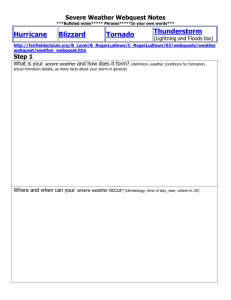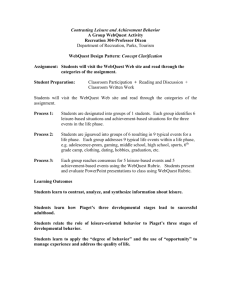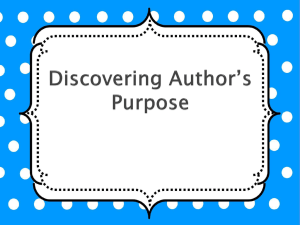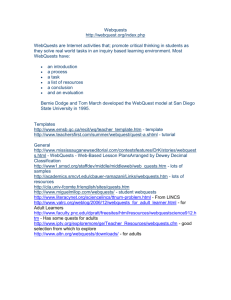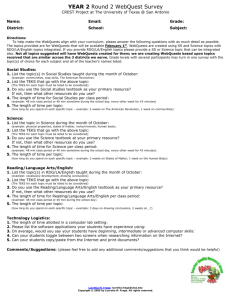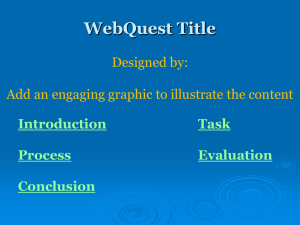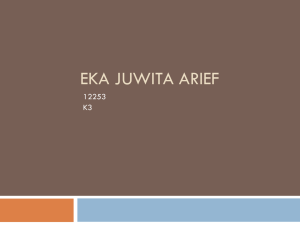Bob Pacheco
advertisement
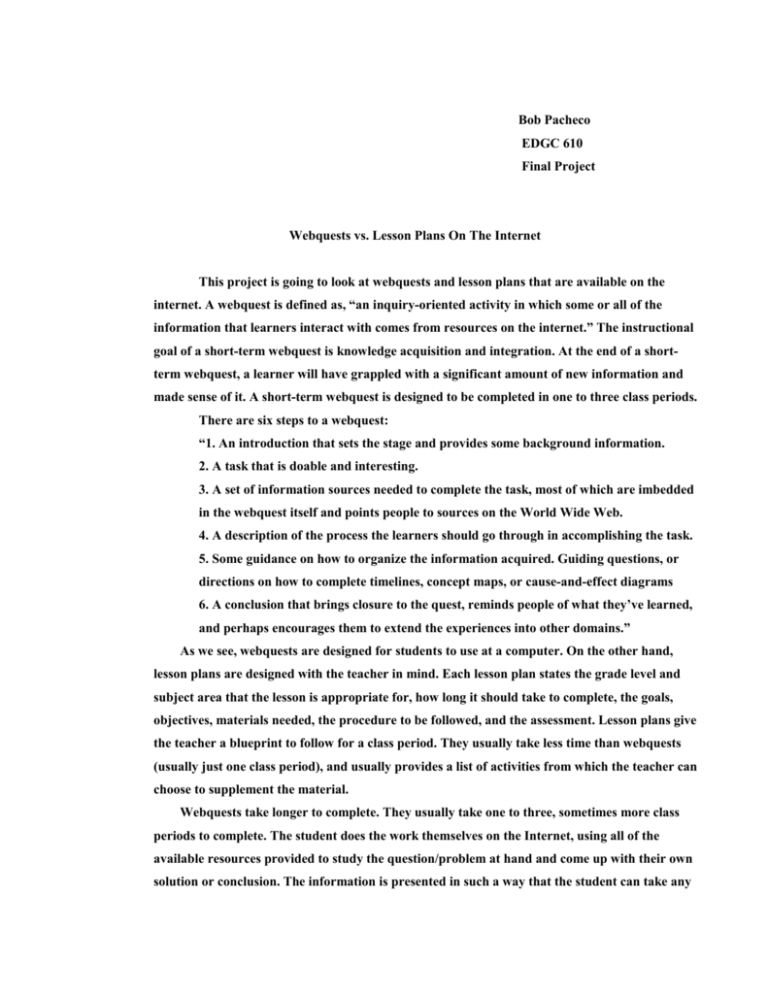
Bob Pacheco EDGC 610 Final Project Webquests vs. Lesson Plans On The Internet This project is going to look at webquests and lesson plans that are available on the internet. A webquest is defined as, “an inquiry-oriented activity in which some or all of the information that learners interact with comes from resources on the internet.” The instructional goal of a short-term webquest is knowledge acquisition and integration. At the end of a shortterm webquest, a learner will have grappled with a significant amount of new information and made sense of it. A short-term webquest is designed to be completed in one to three class periods. There are six steps to a webquest: “1. An introduction that sets the stage and provides some background information. 2. A task that is doable and interesting. 3. A set of information sources needed to complete the task, most of which are imbedded in the webquest itself and points people to sources on the World Wide Web. 4. A description of the process the learners should go through in accomplishing the task. 5. Some guidance on how to organize the information acquired. Guiding questions, or directions on how to complete timelines, concept maps, or cause-and-effect diagrams 6. A conclusion that brings closure to the quest, reminds people of what they’ve learned, and perhaps encourages them to extend the experiences into other domains.” As we see, webquests are designed for students to use at a computer. On the other hand, lesson plans are designed with the teacher in mind. Each lesson plan states the grade level and subject area that the lesson is appropriate for, how long it should take to complete, the goals, objectives, materials needed, the procedure to be followed, and the assessment. Lesson plans give the teacher a blueprint to follow for a class period. They usually take less time than webquests (usually just one class period), and usually provides a list of activities from which the teacher can choose to supplement the material. Webquests take longer to complete. They usually take one to three, sometimes more class periods to complete. The student does the work themselves on the Internet, using all of the available resources provided to study the question/problem at hand and come up with their own solution or conclusion. The information is presented in such a way that the student can take any opinion and go in any direction with the decisions they make. There are no incorrect answers. There isn’t a lot of teacher input, as the students work through the problem on their own. The webquest is specifically designed to be worked through on a computer. Lesson plans tend to put the teacher more in charge, but still leaves opportunities for the students to work on their own. The teacher is in charge of the classroom and remains the central figure in it, while for webquests the students take center stage. Students work through the webquests on their own, while the teacher is there to help them solely with computer functions, if necessary. When would a teacher use a lesson plan versus a webquest in their classroom? It depends. There’s no correct or incorrect time to use one or the other. An argument could be made that webquests are more effective because the student is more engaged, but that may or may not be the case depending on their learning style. Webquests do engage the student more, while lesson plans tend to put the teacher in charge of the class. Lesson plans tend to give the teacher several activities they can choose from to use in class, while the webquest doesn’t offer that variety once students begin. The most important aspect to look at is time. The more time a teacher can spend on a unit, the more appropriate a webquest would be. Since lesson plans take a shorter time to complete, teachers should use them when they have less time to spend on a unit. It’s probably best for a teacher to use a combination of webquests and lesson plans during the school year. Students will like the variety. They won’t be bored expecting the same thing every class period. The best thing for teachers to do is decide how much time they have for a unit. Webquests will give students a deeper understanding of something because of the hands-on aspect, if time permits. If a teacher just has enough time to use a lesson plan, they can still choose from the activities available to best suit their class. Where does a teacher go to find lesson plans and webquests? Two websites, in particular are really good. One is www.google.com . The other is www.lessonplanz.com . On either site, you type in the grade level and subject area you’re interested in on the search engine, and you will literally have hundreds of lessons plans or webquests available at your fingertips. Because there are so many to choose from, the toughest part is deciding which one to use. So, I created a rubric for teachers to grade lesson plans and webquests to help them decide which ones are best for them to use. Many of the characteristics that define a good lesson plan also define a good webquest. With every lesson plan or webquest that a teacher potentially wants to use, they can judge it according to following criteria: WEBQUESTS: -Easy for Students to use: _____ -Grading/Evaluation system: _____ -Clear guidelines for what is expected: _____ -How long webquest will take VS. Time available for unit: _____ -Connectedness to classroom material: _____ LESSON PLANS: -Balance between lecture and activities:_____ -Variety of activities teachers can choose from: _____ -Connectedness to classroom material: _____ -Evaluation system: _____ -Clear guidelines for what is expected: _____ For webquests, it’s very important that the navigation is easy for students to use. You want the student to be learning the ideas behind what the webquest is trying to teach, not learn how to use a computer in order to do the assignment. Teachers should view the webquest before students do them to make sure it is easy to navigate. Most of the webquests that I’ve looked at are. There should be some way of evaluating the worth that students do on the webquest. Is active participation enough, or does the teacher want more, perhaps why the student chose one path to follow instead of another? That’s up to the teacher to decide for each webquest. There should be clear guidelines of what is expected from a webquest. What does the webquest set out to do? What is the “quest”? Students will be more engaged when they know exactly what it is that they are trying to achieve. A negative aspect about webquests is that they are already created and hard for teachers to make them better when they see flaws. Teachers can still use a lesson plan that contains flaws because it is simply a blueprint. It’s up to the teacher to strengthen the weak parts of a lesson plan, and they can do that. On webquests, they can’t. Webquests shouldn’t be used just to get students working on a computer. It should supplement the main lesson that the teacher is trying to get through to the kids. As I mentioned, time is a factor. Teachers should know how long they have for each unit they are going to teach and how they want to divide that time up. They will need some time to lecture. School can’t be all fun and games. The teacher still has to get up there and teach and talk to the students. Students will need time to work on non-computer related material. Teachers should decide how much time they want to devote to kids working on the computers themselves. There should also be connectedness to the classroom material. If a student is going to work on a webquest on the computer, there must be some way in which the webquest is related to the lesson. I’ve seen some webquests that are engaging and interesting, but wonder how they would connect to anything a teacher would be teaching in a classroom. Teachers should look at this qualification when deciding if a webquest is appropriate. In evaluating the webquest, teachers should look at each qualification in the rubric outlined earlier and read the explanations above that followed. Then they rank each qualification from 1 to 10, 1 being poor, 10 being excellent. Obviously, webquests that receive high grades will be great for teachers to use. Webquests that rank low should probably be avoided because teachers can’t alter them they way they can alter lesson plans. Unlike the lesson plans, webquests usually don’t specifically say how long they should take. Its much more vague than the lesson plans that lays it right out. Short-term webquests take anywhere from one to three class periods to complete, while long-term webquests take longer. I couldn’t find in my internet research exactly how long a long-term webquest should take. That is one of the weaknesses of webquests. Its up to the teacher to know the time constraints. Don’t choose a lesson plan or webquets for your class if time doesn’t permit its completion. Like webquests, teachers can use the criteria in the lesson plan evaluation rubric to judge lesson plans. The positive aspect here is that teachers who really want to use them can improve poor lesson plans. In education, there aren’t bad lesson plans, just lesson plans that perhaps aren’t developed enough. Lesson plans should be used as a blueprint anyway, with teachers making minor changes as they see fit. If a teacher sees a flaw, they can improve that aspect and still use the lesson plan as a whole. For lesson plans, we also had five qualifications in the rubric. There should be a balance between lecture and activities. Each lesson plan gives teachers options to use for in-class activities for the students to do, along with what the teacher should talk about preceding the activity. The key here is balance. You don’t want the teacher lecturing too much because the students may not be as engaged. However, the teacher is still the central figure in the classroom and has wisdom that needs to be passed along to the students. So, teachers should look for a balance between lecturing and activities when critiquing lesson plans. Each lesson plan gives teachers activities to choose from for the student s to do. The more activities to choose from, the better. Lesson plans that offer several different activities make the teacher’s job easier. The make-up of each class is different. In some classes, individual activities are better, while in others’ group activities are better. The teacher should know the personality makeup of the class. A quiet class would probably prefer individual-oriented activities, while a talkative class would prefer to work ion groups. Teachers should consider this so the class can work according to their strengths. Just as with webquests, the material in a lesson plan should be connected to what the teacher is teaching in the classroom. A lesson plan with good characteristics will only be good for a teacher if it connects with what they are teaching. If a teacher has to teach a certain unit contained in the curriculum frameworks, the lesson plan should be in close conjunction with it. There should also be a way of evaluating students after the teacher completes the lesson plan. In elementary school I can remember from time to time my teacher would collect our notebooks to make sure we were keeping up with our note taking and assignments. Many of the activities include worksheets for the students to do and the teacher would grade them. Active participation is a plus, but keep in mind that quiet students tend to pay attention although they may not vocally participate. Lastly, there should be clear guidelines of what is expected. If the teacher wants the students to listen, they should listen and not try to take notes. If they are going to be tested on the material, they would probably be more intent on taking notes rather than passively listening so that they can go back and review the main points they listened to. Teachers should look at each of these qualifications for the lesson plan and webquest rubric and judge them accordingly. The higher the grade for the webquest, the more likely they should use it in their classroom. Again, lesson plans aren’t set in stone. So, if a lesson plan evaluation is lacking in some areas, the teacher can change it and make it better. Webquests don’t allow this, however, they do give students a more hands-on approach that they will probably enjoy. Lesson plans and webquests are both effective tools. They each have their place in the classroom. Its up to the teacher to decide the best time to use one or the other.
